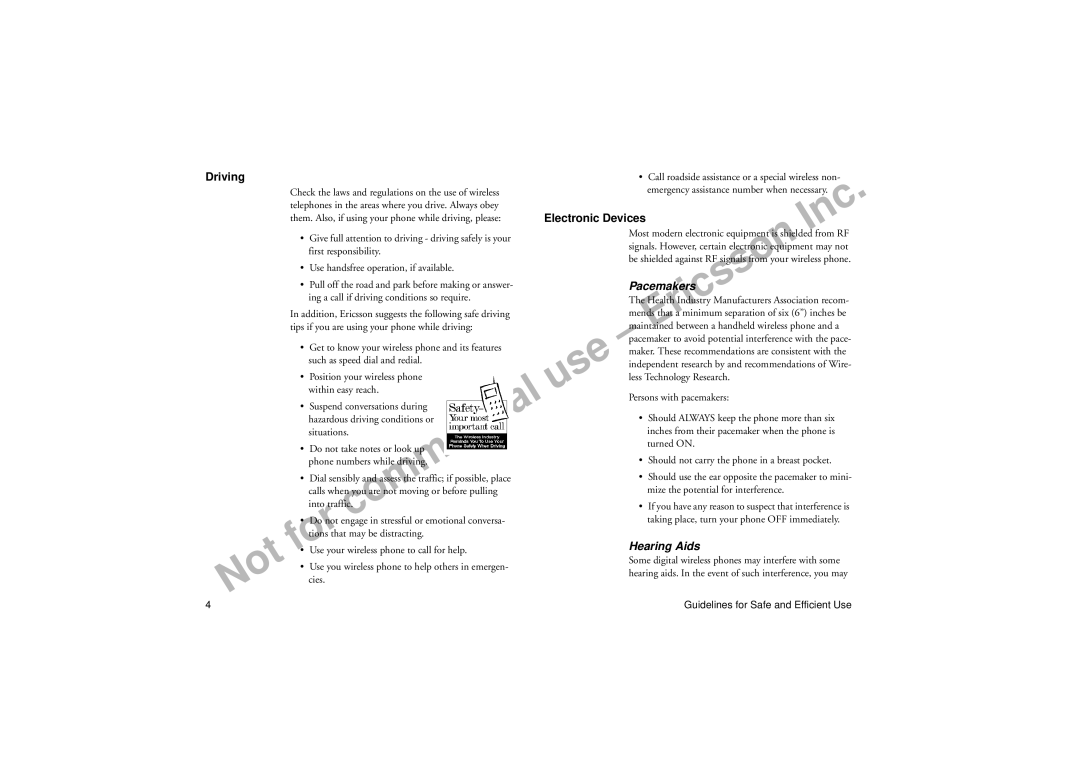
Driving |
|
|
|
|
|
|
|
|
| • Call roadside assistance or a special wireless non- | . | |||
|
| Check the laws and regulations on the use of wireless |
|
|
| emergency assistance number when necessary. | ||||||||
|
| telephones in the areas where you drive. Always obey |
|
|
|
|
|
| c | |||||
|
| them. Also, if using your phone while driving, please: | Electronic Devices |
| n |
| ||||||||
|
|
|
|
|
|
|
|
|
|
|
| I |
|
|
|
| • Give full attention to driving - driving safely is your |
|
|
| Most modern electronic equipment is shielded from RF | ||||||||
|
|
|
|
| signals. However, certain electronic equipment may not | |||||||||
|
|
| first responsibility. |
|
|
|
|
| ||||||
|
|
|
|
|
|
|
| be shielded against RF signalssonfrom your wireless phone. | ||||||
|
| • Use handsfree operation, if available. |
|
|
|
| ||||||||
|
|
|
|
|
|
| s |
|
|
| ||||
|
| • Pull off the road and park before making or answer- |
|
|
| Pacemakers |
|
|
| |||||
|
|
| ing a call if driving conditions so require. |
|
|
| c |
|
|
| ||||
|
|
|
|
|
| The Health Industry Manufacturers Association recom- | ||||||||
|
| In addition, Ericsson suggests the following safe driving |
|
|
| ri |
|
|
|
| ||||
|
|
|
|
| mends that a minimum separation of six (6”) inches be | |||||||||
|
| tips if you are using your phone while driving: |
|
|
| maintainedEbetween a handheld wireless phone and a |
| |||||||
|
|
|
|
|
|
|
|
|
| pacemaker to avoid potential interference with the pace- | ||||
|
| • Get to know your wireless phone and its features |
|
| – |
|
|
|
| |||||
|
|
| e | maker. These recommendations are consistent with the | ||||||||||
|
|
| such as speed dial and redial. |
|
|
| ||||||||
|
|
|
|
|
| independent research by and recommendations of Wire- | ||||||||
|
|
|
|
|
|
| s |
| ||||||
|
| • Position your wireless phone |
|
|
| less Technology Research. |
|
|
| |||||
|
|
| u |
|
|
|
|
| ||||||
|
|
| within easy reach. |
|
|
|
|
|
|
|
| |||
|
|
|
| l |
|
|
| Persons with pacemakers: |
|
|
| |||
|
| • Suspend conversations during |
|
|
|
|
|
|
| |||||
|
|
|
|
|
|
| • Should ALWAYS keep the phone more than six |
| ||||||
|
|
| hazardous driving conditions or |
| rcia |
|
|
|
| |||||
|
|
| situations. |
|
|
|
| inches from their pacemaker when the phone is |
| |||||
|
|
|
|
|
|
| turned ON. |
|
|
|
| |||
|
| • Do not take notes or look up | e |
|
|
| • Should not carry the phone in a breast pocket. |
| ||||||
|
|
| phone numbers while driving. |
|
|
|
|
|
| |||||
|
| • |
| m |
|
|
|
| • Should use the ear opposite the pacemaker to mini- | |||||
|
| Dial sensibly and assess the traffic; if possible, place |
|
|
| |||||||||
|
|
| calls when you are not moving or before pulling |
|
|
| mize the potential for interference. |
|
|
| ||||
|
|
| into traffic. |
|
|
|
|
| • If you have any reason to suspect that interference is | |||||
|
| • |
| com |
|
|
|
|
| taking place, turn your phone OFF immediately. |
| |||
|
| Do not engage in stressful or emotional conversa- |
|
|
|
|
|
|
|
| ||||
|
|
| tions that may be distracting. |
|
|
|
|
|
|
|
|
|
| |
|
| or |
|
|
|
|
|
| Hearing Aids |
|
|
|
| |
| f |
|
|
|
|
|
|
|
|
|
| |||
|
| • | Use your wireless phone to call for help. |
|
|
| Some digital wireless phones may interfere with some |
| ||||||
ot | • Use you wireless phone to help others in emergen- |
|
|
|
| |||||||||
|
|
| hearing aids. In the event of such interference, you may | |||||||||||
| cies. |
|
|
|
|
|
| |||||||
|
|
|
|
|
|
|
|
|
|
|
| |||
N |
|
|
|
|
|
|
|
|
|
|
|
|
| |
|
|
|
|
|
|
|
|
|
|
|
|
|
| |
4
